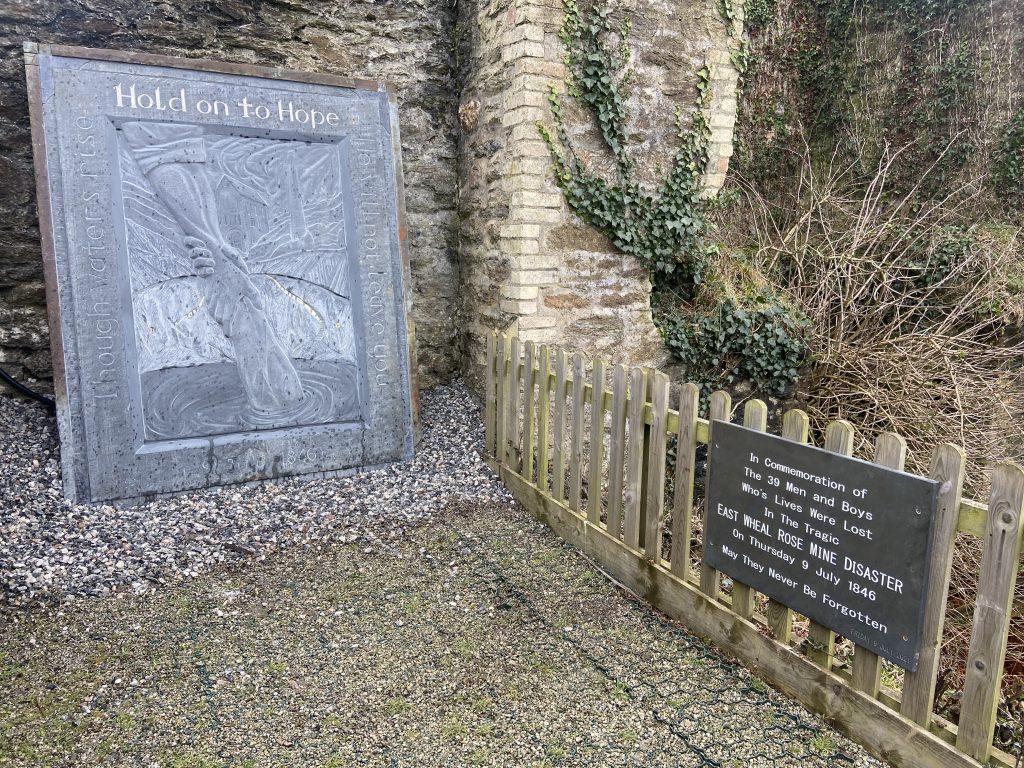East Wheal Rose Mining Disaster
On the morning of 9th July 1846, it was bright and sunny but at midday heavy clouds formed in the north-west and then gathered directly over East Wheal Rose. A tremendous thunderstorm began, lasting more than an hour and a half. Torrential rain fell on the mine and surrounding hills but, strangely there was no rain at all three miles away.
Not long after the beginning of the storm the whole surface of the mine was under water as a flood poured off the southern hills ‘in broad and deep waves’.
Captain Middleton organised 300 men to pile up earth around the collars of the shafts but the volume of water pouring down was so great, and the exit seawards through the Lappa Valley so narrow, that an ocean of water soon overwhelmed the area.
Torrents of water poured down the shafts: the first warning for the unfortunate miners below was when their candles were blown out by a tremendous gale. In utter darkness and surrounded by the roar of rushing water men and boys struggled to find a way out.
There were several miraculous escapes and acts of heroism. Captain Champion was overtaken by the water several times but somehow managed to climb the slippery ladders against the tremendous weight of down-rushing water A timber-man, Samuel Bastion, went down into the mine to lie across a manhole, diverting the flow of water and saving eighteen lives. Another miner returned to the flooded levels in search of his son but neither of them came back.
The beam engines and all the hauling gear had been put to work in raising men to the surface, clinging to the kibbles and chains ‘like strings of onions’ and survivors were taken to the ‘dry’ where the mine doctor took care of the injured.
At the end of the day forty-three men and boys were still missing but four of them were brought up alive next morning. Thirty-nine had lost their lives leaving twenty-two widows and sixty fatherless children.
The lower levels of the mine were completely flooded. But, by November all the debris and water had been cleared and the mine was in full production again.
Commemorating the disaster
175 years on, on Friday 9 July 2021 a commemoration was held at the site of the North Shaft at East Wheal Rose where a plaque was unvieled and remains on display. On 10 March 2023 the main commemorative slate was unvieled having been painstakingly scultped over a number of weeks by sculptor Ben Dearnley at nearby Treseren, the former home to the mine captain, Captain Middleton.
The slate was lifted into position on Tuesday 7th March and unveiled in a modest ceremony at 11.00am on Friday 10th March by Cornish researcher and historian Barry West and sculptor Ben Dearnley.
The slate and the plaque is now on display for visitors of Lappa Valley to see and experience for themselves situated next to the Engine House North Shaft.
Whilst there is much coverage and interpretation surrounding the 39 souls who perished on that fateful day, the commemorative slate represents the over 150 rescued with the enscribed words “Though waters rise, Hold onto Hope, He will not leave you”.
Cornwall Minerals Railway
The Lappa Valley Railway runs on one of the oldest railway track beds in Cornwall. In 1843 J. T. Treffry, a pioneer of Cornish railways, suggested building a tramway between Par and the growing port of Newquay, with a branch to East Wheal Rose mine which was then entering its most prosperous period.

East Wheal Rose Engine House
In 1846 over 1,200 men, women and children were employed in the mine at East Wheal Rose. In those days the valley would have been filled with the sounds of ore being broken up, wagons rolling in and out, steam engines hissing and whistling, and the general hubbub of so many people at work. In an age before television, this scene was the wonder of the neighbourhood and a favourite place for Sunday excursions.

Great Western Railway
In 1896, the Cornwall Minerals Railway was taken over by the Great Western Railway. The GWR saw an opportunity to boost its passenger trade in Cornwall, in competition with the London and South Western Railway, by linking the increasingly popular holiday resorts of Newquay, Perranporth and St. Agnes.

Becoming a Family Attraction
In 1974, just over ten years after the railway closed, Eric Booth bought a section of the old railway line and the story of Lappa Valley Steam Railway began. Through hard work and determination, Eric built the new railway to realise his vision of a place where children and adults could enjoy the steam train experience. His passion for this project was to create a place for children to play safely and learn about nature from their surroundings.


